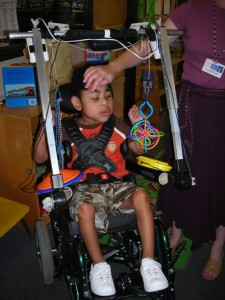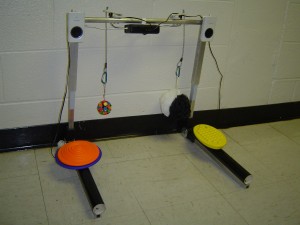Designers: Andres Afanador and Laura Malone
Client Coordinator: Lorin Holmes, Teacher, Durham Public Schools, Durham NC
INTRODUCTION
It is sometimes difficult to find toys for children with disabilities to play with. Because of physical and/or intellectual limitations, they need specially designed toys to keep them interested. Our 4-year old client with cerebral palsy needed a Play Station that would allow him to play by himself, exploring different textures, both in the classroom and while he stays with his mother at work. Since our client has visual impairments, the Assistive Play Station is designed to provide our client with auditory stimuli and provide physical therapy by strengthening movement in his arms, especially his left hand.
SUMMARY OF IMPACT
The Assistive Play Station has given our client something that he can operate simply and enjoy with his senses of touch and hearing. As said by his teacher, “the toys and textures [of the Assistive Play Station] are very age-appropriate for him. Usually, he has to play with toys for infants.”
By locating his favorite textured surfaces and having his favorite songs activated by the buttons to his left, he is motivated to develop the use of his left arm and hand, which are significantly less developed that his right arm and hand. Finally, the adaptability of the device makes it possible to use in a variety of places so that he does not have to be set apart from a group to use it. This allows for interaction with his classmates which also enjoy activating the children’s music by pushing the buttons and tugging on the toys. The client’s teacher listed some ways in which the device would impact our client’s life: “independent exploration, social interaction, he can use it at home and school, work on developing cause/effect skills, works on reach and grasp.”
TECHNICAL DESCRIPTION
The client has limited intellectual capabilities, so we designed the Assistive Play Station (Figures 1 and 2) around the cause-effect stimuli. Because of his visual impairments, we could only use auditory or tactile stimuli. We designed the device with two push switches (commercial) and two pull switches (custom-made) to help him work on different motor tasks. In addition, all of the switches are interchangeable with any commercial switch that uses a standard 1/8” plug, so that the device can grow with the client as his abilities and needs change.
The device is adaptable to three different positions: on the floor over the client, who is lying down; attached to the arms of his wheelchair; or on a table in front of him. With telescoping sides and a rotating frame, the configuration can be changed based on how he is using the device and also can be adapted as he grows.
The Assistive Play Station is built out of an aluminum frame. The top crossbar is made out of ¾” diameter aluminum of 1/16” thickness. The telescoping sides are made from two pieces of aluminum—a ¾” square tubing inside a 1” square tubing. The telescoping tubing is held in place by a quick-release button. Teflon and thin acrylic are attached inside the outer tube in order so that the inner tube can slide easily within the outer one. These telescoping tubes are attached to incremental-angle position hinges. These hinges allow the user to lock the frame at any angle, based on how the client is positioned. For ease of use, we built custom quick-release cams (Figure 2) to allow the user to release the locks. These work in a similar fashion to quick-release levers on bicycle wheels.
The base is made out of ¾” square tubing in order to stabilize the frame. Attached to the base square tubing are 1 ¼” diameter black PVC tubes. The base can be pulled out of the hinge, turned inward, and reinserted so that the PVC tubes face inward. These can then slide over the armrests of our client’s wheelchair for attachment.
When the client activates one of the 4 switches, it directly triggers the μMP3 player (Rogue Robotics, Markham, Ontario, CA) to play the corresponding song. The 4 songs are stored on a Secure Digital (SD) flash card, and different songs can be downloaded to it, using an SD card reader interfaced to a computer. The player is set-up for uninterrupted play mode, meaning that if our client pulls the switch while a song is playing, the song will not restart. The MP3 player connects to battery-powered speakers, which have a volume control for listening to the music. A regulator converts the 9V DC from battery into the 5V needed for circuitry operation.
The total cost of the device is $466




University Operator: (919) 962-2211 | © 2024 The University of North Carolina at Chapel Hill |